This document proposes a set of UML-based specifications for integrating Wireless Sensor and Actor Networks (WSANs) with cloud computing, highlighting the structural relationship and challenges in establishing standards for such integration. It reviews the current state of cloud applications and WSAN technologies, noting the lack of a definitive model for analysis and design in this domain. The research aims to facilitate a framework for effective integration while emphasizing the need for reusable and standard-compliant engineering practices.
![WiSANCloud: a set of UML-based specifications for the
integration of Wireless Sensor and Actor Networks (WSANs) with
the Cloud Computing
Priscill Orue-Esquivel, Bartolomé Rubio
Languages and Computer Science Dept.
University of Málaga
Bulevar Louis Pasteur, 35. 29071
Málaga, Spain
priscill_orue@alu:uma:es, tolo@lcc:uma:es
June 21, 2013
Abstract
Giving the current trend to combine the advantages of Wireless Sensor and Actor Networks (WSANs)
with the Cloud Computing technology, this work proposes a set of specifications, based on the Unified
Modeling Language - UML, in order to provide the general framework for the design of the integration of
said components. One of the keys of the integration is the architecture of the WSAN, due to its structural
relationship with the Cloud in the definition of the combination. Regarding the standard applied in the
integration, UML and its subset, Systems Modeling Language - SysML , are proposed by the Object
Management Group - OMGR
to deal with cloud applications; so, this indicates the starting point of
the process of the design of specifications for WSAN-Cloud integration. Based on the current state of
UML tools for analysis and design, there are several aspects to take into account in order to define the
integration process.
Keywords: Wireless Sensor and Actor Networks (WSANs), Unified Modeling Language (UML),
Cloud Computing (CC), WSANs and CC integration
1 Introduction
Cloud Computing contains applications “exposed as sophisticated services that can be accessed over a net-work”
[6]. For this reason, its advantages are used in combination with other automated systems like WSANs
(Wireless Sensor and Actor Networks). The integration of WSANs with the Cloud Computing has gained
attention due to the benefits of their structural relation. The Cloud provides scalability in terms of process-ing
power and different types of interconnected services while WSANs contain various nodes in charge of
capturing and performing a local pre-processing of data.
Based on the review of the state-of-the-art about the WSAN-Cloud Computing integration, there is not a
definite model for the processes of analysis and design of the said integration. One of the reasons is because
the Cloud per se lacks standards for the interoperability among service providers, consumers and developers
[4].
Of the various paradigms and approaches for analysis and design of systems, the Unified Modeling
Language (UML) is one of the most studied ones for the Cloud environment, as Drusinsky et al [14] and
Kurschl and Beer [10] show in their research. As a result, the main motivation of this work is to contribute
Corresponding author. Phone number: +595 972 646131
1](https://image.slidesharecdn.com/articlemanuscript-141105072154-conversion-gate01/75/WiSANCloud-a-set-of-UML-based-specifications-for-the-integration-of-Wireless-Sensor-and-Actor-Networks-WSANs-with-the-Cloud-Computing-1-2048.jpg)
![a set of specifications that might be applicable to the integration of WSANs with the Cloud Computing,
using UML as a basic standard.
As an initial step, Cloud Computing and WSANs are studied separately from the perspective of the
processes of analysis and design of applications. Following, there is a reflection upon the selection of UML
as the basic standard of this work. As a final section of the theoretical framework, there is a step-by-step
analysis demonstrating the lag of the software engineering process of WSAN-Cloud integration. For the
contribution section, there are separate studies of how the Cloud and the WSANs focus the processes of
analysis and design. Next, the relevant aspects of each component are taken and combined to propose the
specifications for the integration. As a practical demonstration, an example of integration design process is
performed. Finally, several conclusions related to the work - considering the methods and the tools - are
presented at the end of this report.
2 Theoretical Fundamentals and Related Work
This section is intended to offer a review about the theoretical basis of the work. It is divided into three
sub-sections. It starts with the descriptions of the situation of Cloud Computing and the Wireless Sensor
and Actor Networks (WSANs, in order to define the aspects related to engineering processes (analysis,
design and development) within the Cloud. As the final part of this section, the Unified Modeling Language
(UML) is studied to identify the elements that could be applied in the set of specifications for WSANs-Cloud
Computing integration that is going to be defined afterwards.
2.1 Cloud Computing (CC): application development state-of-the-art
Cloud Computing is an emerging technology that provides “on-demand computational capacity as a service”
[15]. This section aims to describe the state-of-the-art of how applications are developed with this approach.
First, the processes of analysis, design and development within the Cloud are analyzed. Then, a brief
discussion of the current state and challenges for the development of Cloud applications is included.
2.1.1 Analysis, design and development of applications within the Cloud
The Cloud Standards Wiki [13] comprises the efforts to standardize the work related to Cloud Computing.
There are several institutions contributing with standards from different areas within the Cloud. These
institutions and their areas of work are summarized in the Table 1.
The most relevant effort for this work is the one from the Object Management Group (OMG)R
. OMGR
offers SysML -a subset of UML- as a tool for modeling within the Cloud. According to the OMGR
, SysML
“is a general-purpose graphical modeling language for specifying, analyzing, designing, and verifying com-plex
systems that may include hardware, software, information, personnel, procedures, and facilities” [12].
Therefore, this tool appears to be a promising one that would help to reach the goals of this work.
However, when reviewing the SysML specifications, there is no direct relationship with the Cloud. This
implies that The Cloud Standards Wiki [13] contemplates SysML as an alternative for analysis and design in
the Cloud context, but the modeling tool is not directly related to the Cloud. Thus, there is a unidirectional
relationship. In brief, the processes of analysis, design and development of applications within the Cloud
are not overtly defined in terms of specifications or standards, but there is a tentative standard that can be
reused for the purposes of this work.
2.1.2 Current state and its challenges for application development
Armbrust et al [3] summarizes the current state and the challenges offered by the Cloud Computing in
Figure 1. The first obstacle-opportunity can be handled by having multiple Cloud Computing providers.
“One solution would be to standardize the APIs in such a way that a SaaS developer could deploy services
and data across multiple cloud computing providers so that the failure of a single company would not take
2](https://image.slidesharecdn.com/articlemanuscript-141105072154-conversion-gate01/75/WiSANCloud-a-set-of-UML-based-specifications-for-the-integration-of-Wireless-Sensor-and-Actor-Networks-WSANs-with-the-Cloud-Computing-2-2048.jpg)
![Organization Contribution
Cloud Security Alliance Promotes “the use of best practices for providing security assur-ance
within Cloud Computing, and provide education on the uses
of Cloud Computing to help secure all other forms of computing”
Cloud Standards Customer Council End user advocacy group that is dedicated to accelerate the
“cloud’s successful adoption, and drilling down into the standards,
security and interoperability issues surrounding the transition to
the cloud.”
Distributed Management Task Force (DMTF) Focused on “standardizing interactions between cloud environ-ments
by developing cloud management use cases, architectures
and interactions.”
European Telecommunications Standards In-stitute
(ETSI)
Aims to “address issues associated with the convergence between
IT (Information Technology) and Telecommunications”
National Institute of Standards and Technol-ogy
(NIST)
Working on the definition of Cloud Computing
Open Grid Forum (OGF) A organization that develops standards “operating in the areas of
grid, cloud and related forms of advanced distributed computing.”
Object Management Group (OMG)R
Focuses “on modeling, and the first specific cloud-related speci-fication
efforts have only just begun, focusing on modeling de-ployment
of applications and services on clouds for portability,
interoperability and reuse.” The most important specification re-lated
to the Cloud is SysML, which will be later discussed in this
work.
Open Cloud Consortium (OCC) It has a particular focus in large data clouds
Organization for the Advancement of Struc-tured
Information Standards (OASIS)
Leads the “development, convergence and adoption of open stan-dards
for the global information society.” Most of its foundational
standards are a natural extension of SOA and network manage-ment
models.
Storage Networking Industry Association
(SNIA)
Originated “the Cloud Storage Technical Work Group for the pur-pose
of developing SNIA Architecture related to system implemen-tations
of Cloud Storage technology”
Cloud Work Group Focuses on creating “a common understanding among buyers and
suppliers of how enterprises of all sizes and scales of operation can
include Cloud Computing technology in a safe and secure way in
their architectures to realize its significant cost, scalability and
agility benefits”
Association for Retail Technology Standards
(ARTS)
They work on the usage of the Cloud for retailers
TM Forum Helps enterprises to adopt and use digital information services for
business effectiveness
Table 1: Summary of organizations working on Cloud standards [13]
3](https://image.slidesharecdn.com/articlemanuscript-141105072154-conversion-gate01/75/WiSANCloud-a-set-of-UML-based-specifications-for-the-integration-of-Wireless-Sensor-and-Actor-Networks-WSANs-with-the-Cloud-Computing-3-2048.jpg)
![all copies of customer data with it.” On the other hand, the responsibility for security is shared by many
parties; and developers have to check their applications comply with security standards [3].
Aoun et al [2] proposes the term “resource abstraction” to facilitate management of Cloud resources
applying “heterogeneity, scalability, and confidentiality issues that impact, in general, the sharing and renting
of distributed resources”. With this approach, Third-Party Service Providers (TPSPs) can hide the details of
their resources through the summarization of physical resource information. Moreover, resource abstraction
includes “mechanisms to represent, advertise and rent out their available resources in a uniform and scalable
manner”. This abstraction refers to network and IT resources abstraction.
Figure 1: Obstacles and opportunities for Cloud Computing growth [3]
Tao et al [15] claims that “Cloud technology is currently still in the development phase. Many issues,
like data security and monitoring, are still not considered or have to be improved.” For these reasons, plus
the ones described by Armbrust [3], the current situation of the Cloud is defined by the presence of various
standards aiming to reach a consensus on several aspects. The main challenge, however, is to define a specific
standard for application development.
2.2 Wireless Sensor and Actor Networks (WSANs): current situation of appli-cation
development
Wireless Sensor and Actor -sometimes referred to as “actuators” in the literature- Networks are capable of “ob-serving
the physical world, processing the data, making decisions based on the observations and performing
appropriate actions”. This section introduces several concepts related to WSANs. In the beginning, a com-prehensive
analysis of the structure and operation of WSANs is performed. Then, the contexts of WSANs’
applications are presented, with a strong emphasis with Cloud Computing integration. Finally, there is a
description of the current situation of the processes of analysis, design and development of applications with
WSANs.
2.2.1 Operation and structure of WSANs
There are two important roles in a WSAN: sensor and actor. A WSAN collects data from the environment
where it is inserted and then performs appropriate actions taking into account the collected data. Like Figure
2 shows, “these nodes are scattered in the sensor/actor field while the sink monitors the overall network and
communicates with the task manager node and sensor/actor nodes” [1].
4](https://image.slidesharecdn.com/articlemanuscript-141105072154-conversion-gate01/75/WiSANCloud-a-set-of-UML-based-specifications-for-the-integration-of-Wireless-Sensor-and-Actor-Networks-WSANs-with-the-Cloud-Computing-4-2048.jpg)
![Figure 2: The physical architecture of WSANs [1]
Sensors that detect a phenomenon can transmit their data to the actor nodes which process all incoming
data and initiate appropriate actions; this is called Automated Architecture because of the absence of a
central controller, like human interaction. Another alternative is when sensors route data back to the sink
which issues action commands to the actors in the network. In this case, the sink - acting as the central
controller - collects data and coordinates the acting process [1]. The difference is perceived in Figure 3
Figure 3: Automated and Semi-automated architecture of WSANs [1]
Sensor nodes contain a power unit, communication subsystems (receiver and transmitter), storage and
processing units, Analog to Digital Converter (ADC) and the sensing unit. The role of the sensing unit is to
monitor phenomena like thermal, optic or acoustic events. Then, “the collected analog data are converted
to digital data by ADC and then are analyzed by a processor and then transmitted to nearby actors” [7].
The controller, which is a decision unit, takes sensor readings as input and produces action commands
5](https://image.slidesharecdn.com/articlemanuscript-141105072154-conversion-gate01/75/WiSANCloud-a-set-of-UML-based-specifications-for-the-integration-of-Wireless-Sensor-and-Actor-Networks-WSANs-with-the-Cloud-Computing-5-2048.jpg)
![as output. At that point, the commands are converted to analog signals by the Digital to Analog Converter
(DAC) and are transformed into actions “via the actuation units”. There are integrated sensor/actor nodes
that can substitute actor nodes. “Since an integrated sensor/actor node is capable of both sensing and acting,
it has sensing unit and ADC in addition to all components of an actor node.” [7]. Figure 4 displays the
structure of both sensors and actors.
Figure 4: (a) Sensor and (b) Actor nodes architectures [7]
2.2.2 Analysis, design and development of applications with WSANs
The problem of the lack of consensus for the development of WSAN applications goes back to WSNs (Wireless
Sensor Networks), the predecessors of WSANs. Zhao and Guibas [19] affirm that new technological advances
bring new challenges for “information processing in sensor networks. What is needed are novel computational
representations, algorithms and protocols and design methodologies and tools to support distributed signal
processing, information storage and management, networking, and application development.”
However, several efforts have been initiated towards a model of development of WSAN applications. “The
provisioning of sensor information is seen as a basic requirement for enabling information and services that
respond to changes in context of state or being”. Current and existing research has depended mainly on the
principles of middleware solutions, which allows acquisition and dissemination of useful information [16].
From Kurschl and Beer’s experience [10], the current available tools for design and analysis have ad-vantages.
Several programming languages and different kind of devices can be put in service and easily
interconnected. “It provides a lot of flexibility in terms of programming languages and devices, but this come
with the drawback of heterogeneity, which quite often leads to more complexity.”.
In brief, there are models and strategies to perform the design and development of WSAN-based appli-cations.
From the reviewed literature, the most remarkable one is the use of middlewares. Nevertheless,
evidence of models or techniques for analysis was not found.
2.3 UML and SysML: concepts for WSAN-Cloud integration
“The major benefits of OO modeling, design and subsequent implementation are reusability, reliability,
robustness, extensibility, and maintainability” and these features are essential to keep on with WSAN-Cloud
application development. Within this context, where application development evolves in a fast pace, it is
necessary to rely on approaches like UML (Unified Modeling Language) that emphasize re-usability and
encapsulation. The main idea is to build models which constitute an architecture “with details hidden inside
shared objects exposing interfaces and methods for interaction and usage”[16].
Objects can be serialized, which is to convert them into bits for storage in file [9]. This feature makes
possible that linked architectures can construct and deliver objects where requested, protecting sensitive
6](https://image.slidesharecdn.com/articlemanuscript-141105072154-conversion-gate01/75/WiSANCloud-a-set-of-UML-based-specifications-for-the-integration-of-Wireless-Sensor-and-Actor-Networks-WSANs-with-the-Cloud-Computing-6-2048.jpg)
![information, like sensor passwords. “Such a model enables a high level of dynamic behavior; and when
coupled with an object oriented persistence,” there is a responsive and scalable solution [16].
From all the conventions within UML, the subset to be applied in this work is SysML. SysML includes
“a strongly formed, constructed set of methods, ready for serious systems engineering application” [17].
SysML provides several benefits like the inclusion of standardized and comprehensive system specification
paradigm with the usage of graphic symbols with unambiguous meaning. Moreover, it avoids the need to
normalize system definitions and, as its father UML, it allows reuse as well as it simplifies “distributed team
environments”[17]. However, like mentioned in [17], tools for SysML are still in development, even at the
time of development of this study. For this reason, particular settings applied in this proposal are explained
in detail, in order to guide the understanding of the work.
2.4 WSAN-Cloud Integration: previous studies
Regarding WSAN-Cloud integration, Kurschl and Beer [10] propose a system in which they combine two
architecture models: “1. SOA Roles in proposed Architecture; and 2. Internet and Integration Controller
interaction Architecture(IICiA) (using cloud technology)”. The sensor nodes and integration controller are
able to interact through SOA architecture. Sensor nodes constitute service providers and sink nodes as seen
as consumers the get the information through the Integration Controller.
Another method for WSAN-Cloud integration is through the Publish-Subscribe systems, proposed by
Walters [16]. These systems offer a mechanism to disseminate information where there is no need of a
priori knowledge regarding information requirements. Figure 5 shows an information source enabling an
interface for sinks to submit a subscription request. When the request is approved, the “source periodically
sends updated information to the sink based on the subscription request”. The source owner has no need to
know this in advance of the request. One point in detriment of these systems is their application in large
infrastructures due to the need of resources to handle large numbers of requests. However, there are some
approaches in [8] trying to solve this disadvantage.
Figure 5: Architecture of Publish/Subscribe systems [16]
This work is a contribution of UML-based specifications to integrate WSANs with the Cloud Computing.
Considering the literature related to the field, this is a ground-breaking work as far as it is known, because it
takes into account a systems engineering standard in order to integrate two components with similar charac-teristics
from the structural point of view. It deals with the individual features of the Cloud Computing and
WSANs, with the main goal of finding aspects that interrelate them, so as to build a schema of integration,
following a renowned standard.
2.5 Common aspects from WSANs and Cloud Computing related to analysis,
design and development of applications
This is a summary of the processes of analysis, design and development from three viewpoints: Cloud
Computing, WSANs and UML. The idea is to put in a nutshell the concepts studied in the theoretical
framework, in order to have a view of the work which will be developed.
From the summary presented in Table 2, there is a lag in the software engineering process applied in
WSANs and a proposal of a framework of analysis and design from Cloud Computing, based on UML.
Therefore, the main goal of this work is to create a link of analysis and design of applications based on the
7](https://image.slidesharecdn.com/articlemanuscript-141105072154-conversion-gate01/75/WiSANCloud-a-set-of-UML-based-specifications-for-the-integration-of-Wireless-Sensor-and-Actor-Networks-WSANs-with-the-Cloud-Computing-7-2048.jpg)
![Process /
Area
Cloud Computing WSANs UML
Analysis OMG proposes SysML as
an alternative, according
to The Cloud Standards
Wiki [13]
No proposed standards or
tools in reviewed litera-ture
The most approximate tool for the
purposes of this work is SysML as
a “a general-purpose graphical model-ing
language for specifying, analyzing,
designing, and verifying complex sys-tems
that may include hardware, soft-ware,
information, personnel, proce-dures,
and facilities” [12].
Design OMG proposes SysML as
an alternative, according
to The Cloud Standards
Wiki [13]
No proposed standards or
tools in reviewed litera-ture
The most approximate tool for the
purposes of this work is SysML as
a “a general-purpose graphical model-ing
language for specifying, analyzing,
designing, and verifying complex sys-tems
that may include hardware, soft-ware,
information, personnel, proce-dures,
and facilities” [12].
Development The Distributed Manage-ment
Task Force (DMTF)
is working on issues like
portability, cloud archi-tecture,
interfaces, man-agement
and auditing [13]
Commonly, Middlewares
are used as the basis
for application develop-ment
(Walters [16])
Not applicable
Table 2: Summary of the processes in application development based on WSAN-Cloud Integration
WSANs-Cloud integration, through the UML standard; thus, the concept of reutilization will be applied, to
avoid “reinventing the wheel”.
3 Design of specifications to integrate WSANs with the CC, con-sidering
UML
The design of specifications to integrate WSANs with the Cloud technology takes into account UML as a
basic standard for this work. The aspects to be considered are taken from the generic UML and a subset of
it called SysML (System Modeling Language). “SysML reuses a subset of UML 2 and provides additional
extensions to satisfy the requirements of the language” [12]
Therefore, this section will analyze the requirements for WSANs and Cloud Computing, both separately
and together. The steps to be followed consist in the following:
Define and describe analysis and design-related aspects about WSANs
Define and describe analysis and design-related aspects about the Cloud
Define and describe analysis and design-related aspects from WSANs and the Cloud together
Define and propose a set of specifications using UML/SysML.
3.1 Analysis and design-related aspects about the Cloud
Figure 6 shows an overview of the Cloud aspects to consider when developing an application, both for SaaS
and PaaS. As it can be seen, the nodes directly involved with the Cloud technology are: actors, resources
8](https://image.slidesharecdn.com/articlemanuscript-141105072154-conversion-gate01/75/WiSANCloud-a-set-of-UML-based-specifications-for-the-integration-of-Wireless-Sensor-and-Actor-Networks-WSANs-with-the-Cloud-Computing-8-2048.jpg)
![and standards. This means that it is crucial to analyze the entities that are going to play roles in the
infrastructure, the tools that are going to be used including which target the work will be aimed at and the
points in question to deal with usability and maintainability.
After the general overview of the aspects to deal within the Cloud, Figure 7 represents the categories to
be studied in the form of a Requirement Diagram. Being the Cloud a starting point, the whole structure
is depicted in a hierarchical form. “A composite requirement can contain subrequirements in terms of a
requirements hierarchy, specified using the UML namespace containment mechanism.” [12]
Figure 8 includes all the actors in the Cloud. Due to limitations of the modeling tool [5], it is important
to note that blocks containing the link between users, providers and services are represented as packages
that satisfy the requirements. Moreover, it is denoted that clients might not need a subscription to access
the provided services, but it is still suggested that a temporary type of subscription be created while the
provision of the service is taking place.
Regarding resources, Figure 9 details the requirements to build a Cloud. As mentioned in the theoretical
section, this work focuses in the Cloud from two viewpoints: Software-as-a-Service (SaaS), and Platform-as-
a-Service (PaaS); this is the reason why the Cloud_Service requirement is decomposed in two other
requirements. From those points of view, both, the Service_Level_Agreement and Cloud_Type_Policy
requirements are requirements that need to satisfy the two approaches, in order to have them working
properly.
Taking into account all the efforts to standardize the Cloud, which are summarized in Table 1, Figure 10
represents the general requirements to operate, model and maintain Cloud applications. Packages represent
external entities that satisfy the needs. For example, the package Telecommunication_Policy ensures that
a given cloud is interoperable and portable with other ones, as well as it guarantees scalability of the modeled
applications.
3.2 Analysis and design-related aspects about WSANs
After identifying the requirements for Cloud-based applications, this section describes the requirements for
Wireless Sensor and Actor Networks (WSANs). Figure 11 denotes a general overview of WSANs’ require-ments,
both from the structural and developmental points of view. The network architecture plays an
important role when defining the pieces of the whole picture. This means that the branch development
aspects changes according to the structure of the network. However, for this work, all possible sensor-actor-controllerNode
combinations are taken into account.
From the map displayed in Figure 11, the corresponding analysis is as follows: structure and implemen-tation.
Figure 12 details the components in terms of requirements and how they are associated. For the
purposes of this analysis, the actor and sensor nodes are represented as packages, since they contain their
own specifications for their implementation.
Based on the standards listed in Table 1, node interconnection within the network is the first point in
common when comparing with the components defined in the Cloud. Telecommunication aspects also play
an important role to satisfy communication and storage needs. These aspects plus the requirements defined
in Figures 12 and 13 are taken into account for the development of WSAN-based applications.
3.3 Analysis and design-related aspects from WSANs and the Cloud together
The analysis and definition of design-related aspects of the Cloud and WSANs are used to describe the points
to deal when trying to integrate these two fields. As mentioned earlier, the first point in common between
the Cloud and the WSANs refers to communication among internal entities and also to the external world.
Therefore, the goal is to define the set of requirements to integrate WSANs to the Cloud.
Figure 14 is a synthesis of the items enumerated as requirements in previous analysis of the Cloud and
WSANs, separately. Since both entities share several attributes, the map is reorganized taking into account
two main branches: Development_aspects and Resources. In this way, what is available and what rules
have to be fulfilled are displayed as requirements.
9](https://image.slidesharecdn.com/articlemanuscript-141105072154-conversion-gate01/75/WiSANCloud-a-set-of-UML-based-specifications-for-the-integration-of-Wireless-Sensor-and-Actor-Networks-WSANs-with-the-Cloud-Computing-9-2048.jpg)
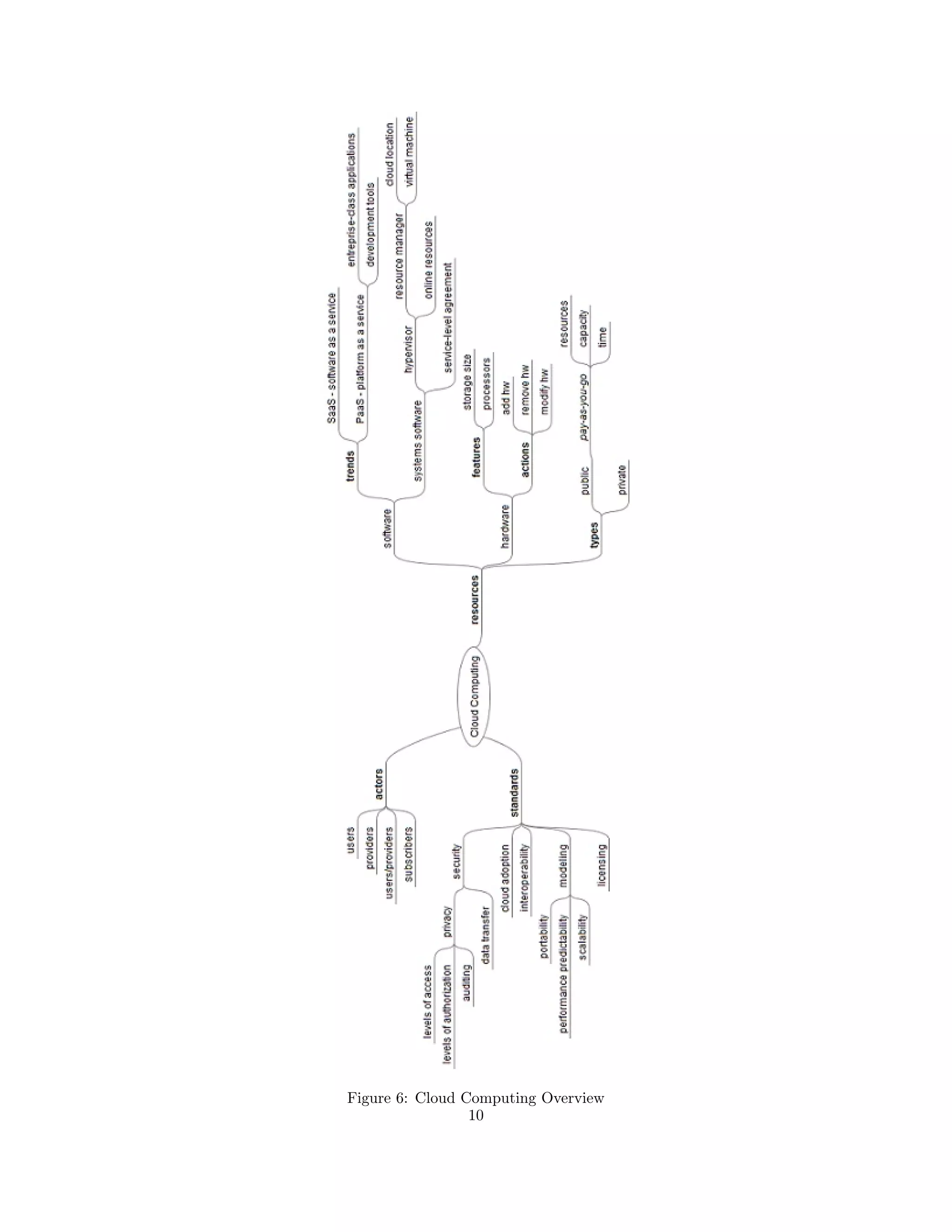
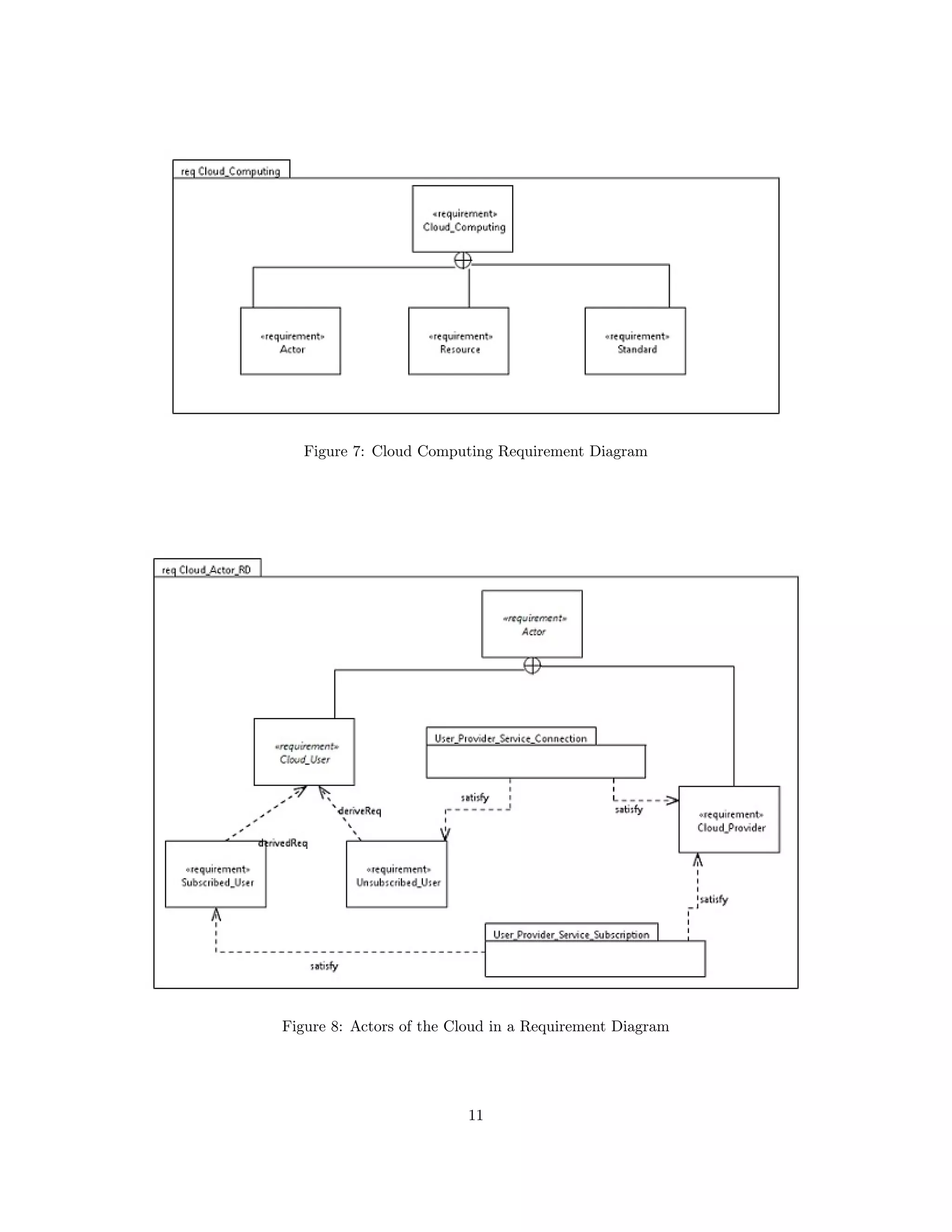
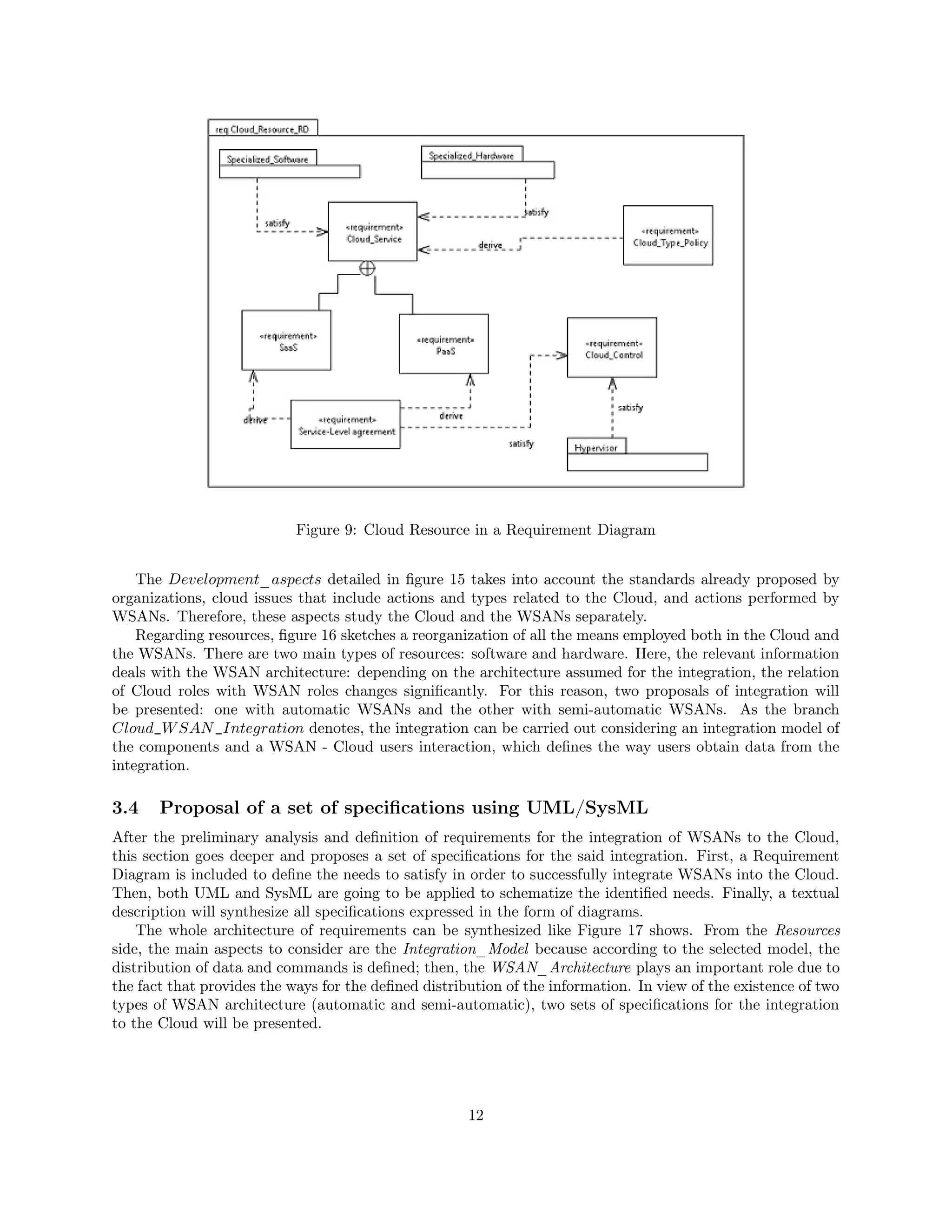
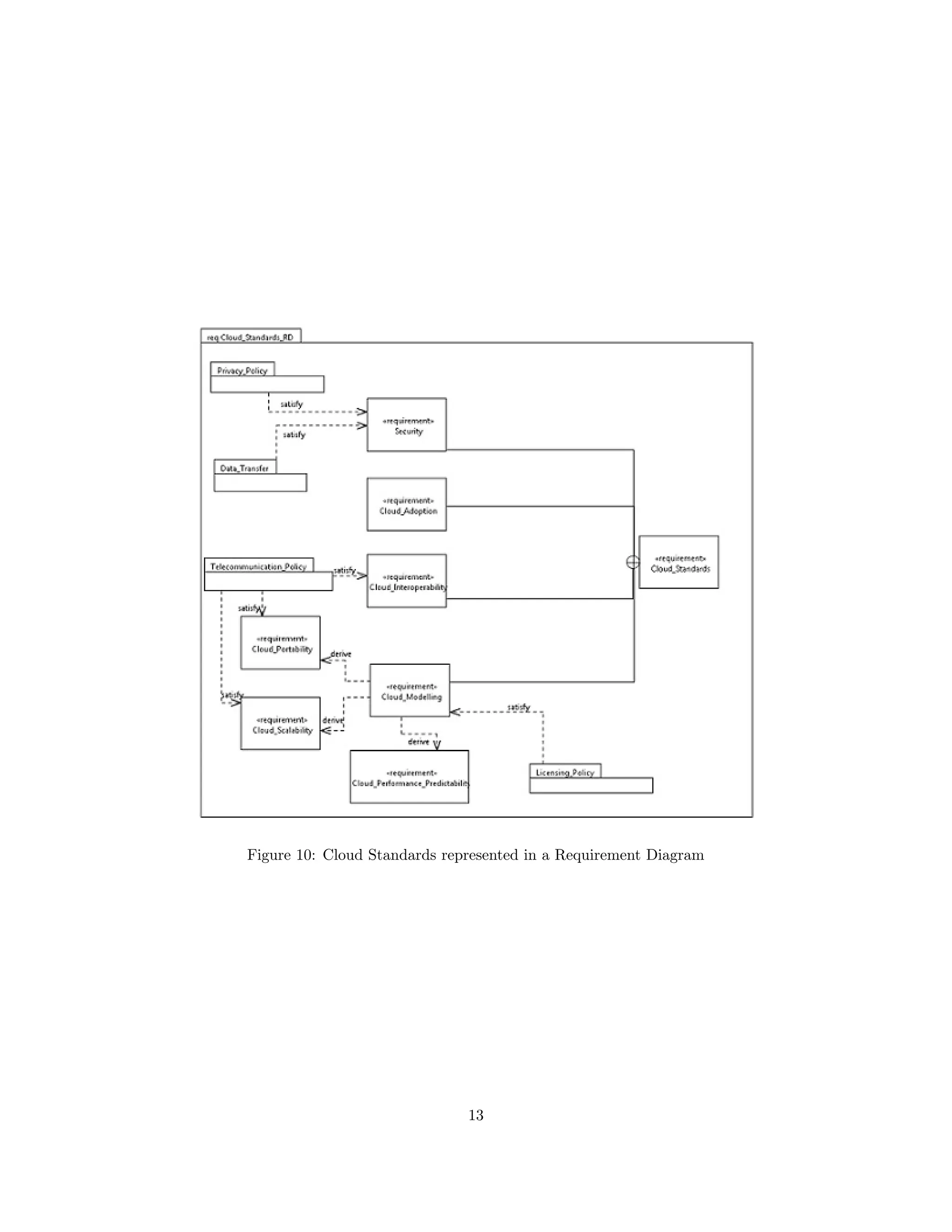
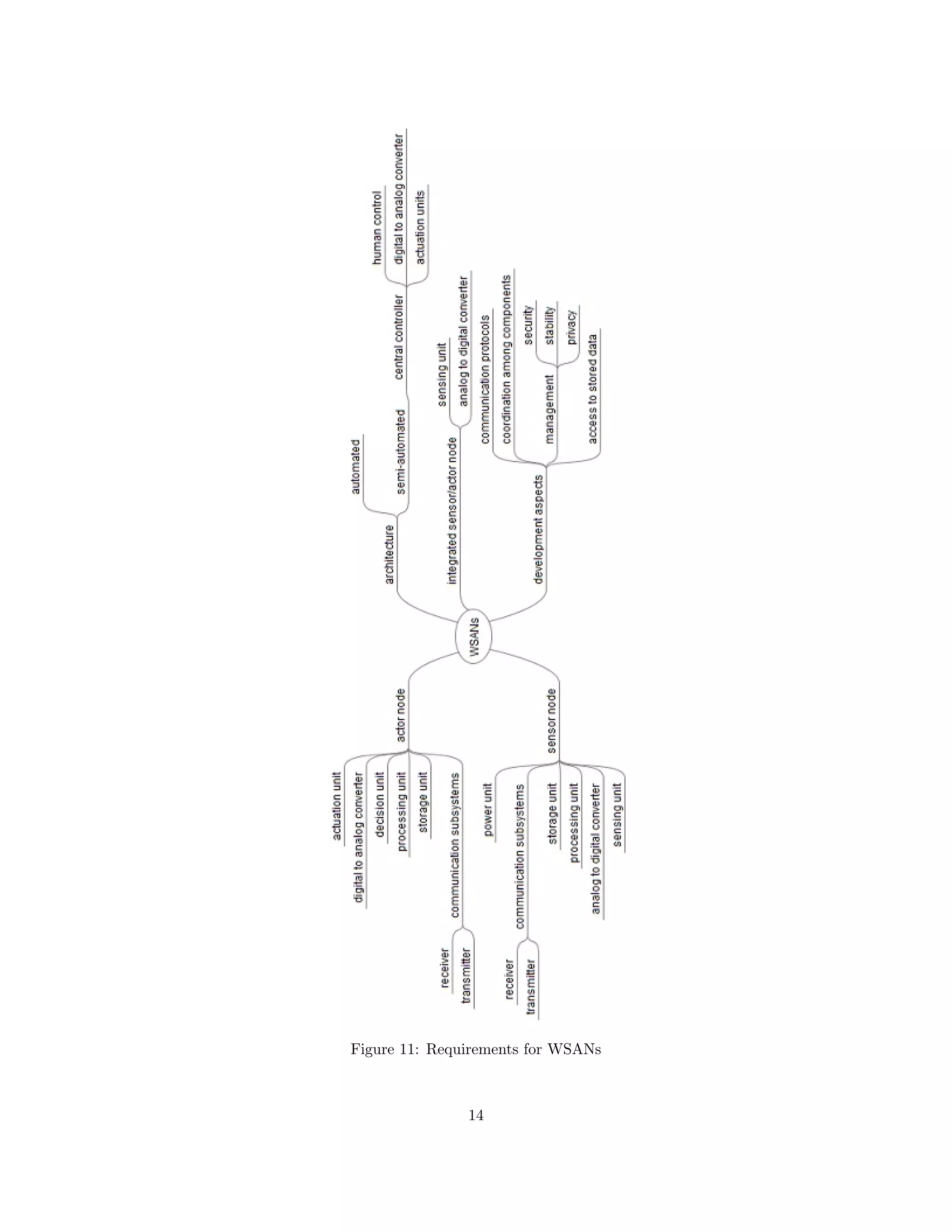
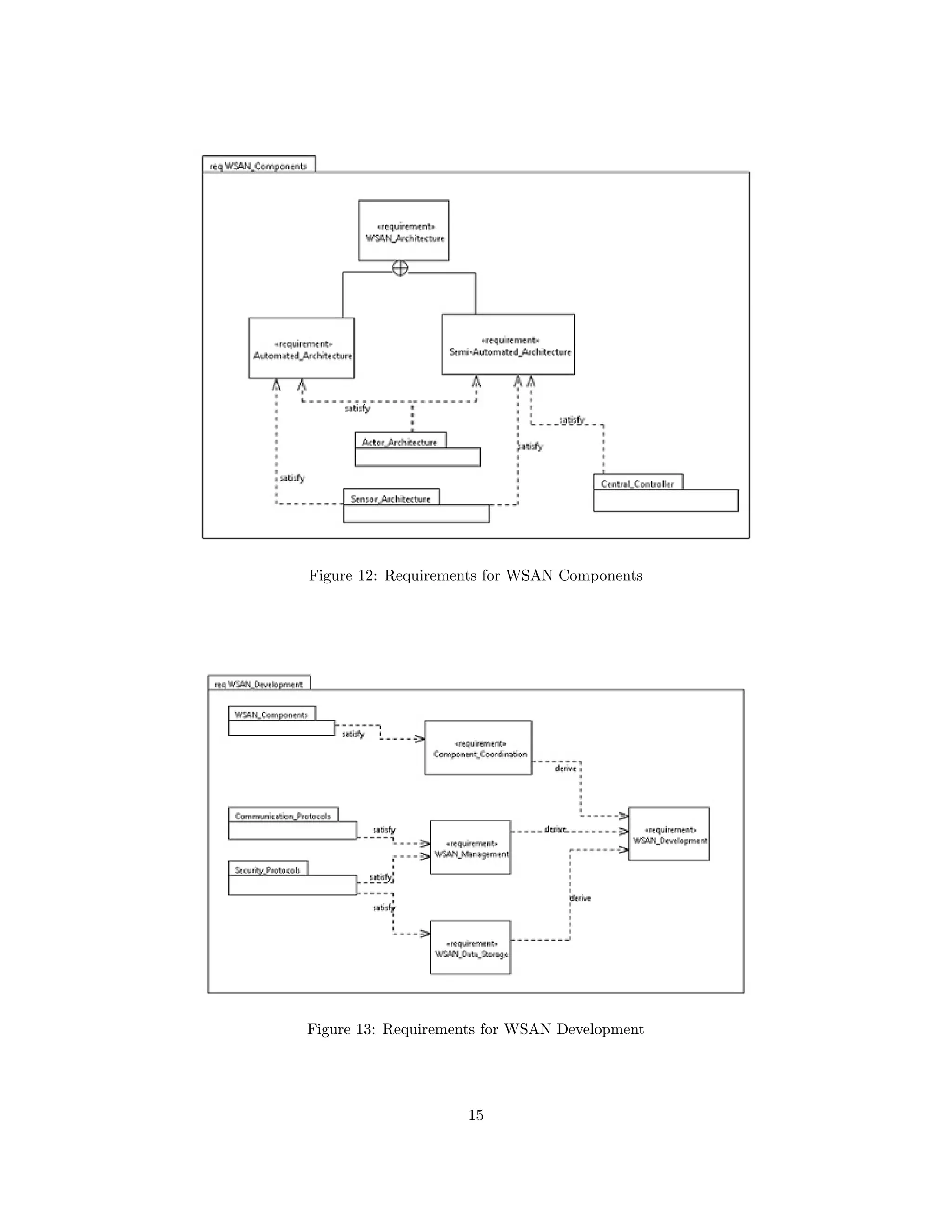
![Figure 14: CloudComputing and WSANs proposed aspects for integration
Figure 15: CloudComputing and WSANs: Development aspects
3.4.1 Set of specifications for the integration of semi-automatic WSANs with the Cloud
Since the Cloud has the roles of users and providers, WSANs - with their sensors and actors - fit in this
overview. In other words, Cloud_users are related to WSAN actor nodes, while Cloud_providers are
related to WSAN sensor nodes. On the other hand, Cloud capabilities can be applied to manage WSANs
through a Publish/Subscribe model of integration.
Necessary conditions for WSAN-Cloud integration are already defined via Requirement Diagrams; there-fore,
Block Diagrams are going to be used to propose the set of specifications. Blocks constitute modular
units of system description and define a collection of features to describe a system under study. They may
include “both structural and behavioral features, such as properties and operations” [12]. To define a start-ing
point, Figure 18 summarizes the areas to be worked on represented by packages, and how the system is
related to external entities (users, other systems, etc) through the Resources of the integration.
Development_aspects includes WSAN and Cloud elements, actions and standards. Regarding WSAN
actions, data type of the sensed and processed data is unknown in this level (here, WSANs are treated
generically), for this reason there are not data types specified in the Block Diagram of Figure 19. Besides,
standards are considered as packages that are conformed both by the Cloud and the WSAN to be integrated.
Finally, since the two parties are independent in this level, all components are encapsulated.
Figure 20 displays the necessary resources to take into account when performing the integration. As
16](https://image.slidesharecdn.com/articlemanuscript-141105072154-conversion-gate01/75/WiSANCloud-a-set-of-UML-based-specifications-for-the-integration-of-Wireless-Sensor-and-Actor-Networks-WSANs-with-the-Cloud-Computing-16-2048.jpg)
![Figure 16: CloudComputing and WSANs: Resources
mentioned earlier, the architecture of the integration relates WSAN sensors as Cloud providers, WSAN
actors as Cloud users, External entities as Cloud monitors and the WSAN central controller that acts as the
sink in the Publish/Subscribe model. Cloud monitors establish the criteria of how actors and sensors should
perform and to which entities report the sensed data, for this reason, they are considered as external entities
regarding the Cloud.
The overview of the elements conforming the Resources is depicted in Figure 21. In this level, the
resources necessary for the integration are hardware and software. The ExternalEntity actor, which maybe
a human user or any other monitoring system, is directly related to the hardware because it deals with the
architecture of the integration.
The software resources needed for Semi-Automatic WSAN and Cloud integration are the same ones
related to both parties, to ensure normal functioning. The relevant module, as showed in Figure 22, is
the WSAN_Cloud_Interface. The ports attached to each block denote the flow of data among the
parties: wsan_interface (WSANSoftware block) to interface_wsan (WSAN_Cloud_Interface block),
for instance. Finally, the block Cloud_Software has to conform to the selected approach (public or private
cloud), represented by the package Cloud_Approaches.
The block definition diagram sketched in Figure 23 denote that the ExternalEntity monitors the WSAN-Cloud
integration through the CentralController within the hardware architecture. Then, this controller
issues commands to the DataTarget block, where WSAN actors are related to the Cloud users. At the same
time, the controller retrieves the information of the DataSource block, where WSAN sensors are related to
the Cloud providers, in order to process it and fulfill the subscriptions indicated by the external entity.
In brief, integration of semi-automatic WSANs with the Cloud Computing can be performed associating
the sensors to the providers, the actors to the users and monitoring these via a central controller. This
schema is governed by a publish/subscribe mechanism which is monitored by an external entity (human user
or another system).
3.4.2 Set of specifications for the integration of automatic WSANs with the Cloud
As mentioned earlier, in automatic WSANs sensors detect a phenomenon and send the data to actors which
process the information to perform appropriate actions. In [11] there is a comprehensive state of the art
17](https://image.slidesharecdn.com/articlemanuscript-141105072154-conversion-gate01/75/WiSANCloud-a-set-of-UML-based-specifications-for-the-integration-of-Wireless-Sensor-and-Actor-Networks-WSANs-with-the-Cloud-Computing-17-2048.jpg)
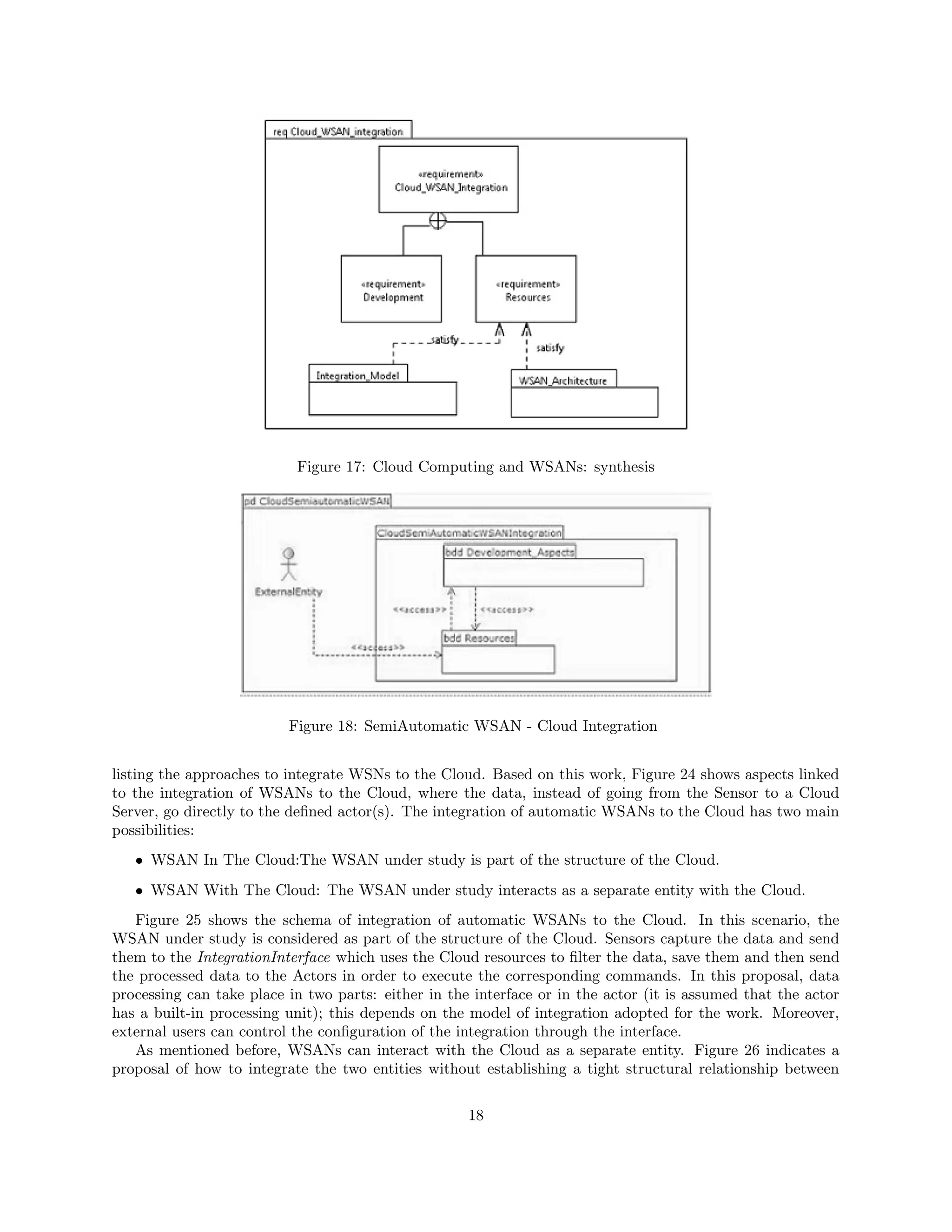
![Figure 19: Block Diagram for the Development Aspects
them. The important concept is the introduction of the IntergrationInterface as a mean to communicate the
WSAN and the Cloud. A possible variation of this approach could be to directly connect the Cloud to the
WSAN Actor to issue the commands to be executed. Finally, external users can monitor or control events
through the Cloud.
After describing all the necessary elements and concepts to perform a WSAN-Cloud integration, Figure
27 summarizes the ideas to take into account. First of all, it is important to divide the work into two
main Components: Development_Aspects and Resources, where the first one studies the WSAN and the
Cloud as separate entities while the second one assumes the common points for the integration. Then, the
WSAN_Type defines the methods to be adopted for the integration. Finally, the Cloud_userinteraction
indicates the model to be used for the interaction of external users with the integration.
4 Application of the proposed design: a case study
A good way to demonstrate de validity of the proposed set of specifications for the integration of WSANs to
the Cloud is to carry out a practical application. Following, a description of the context of study is presented
and, then, the implementation of the proposal is fulfilled. The aim is to set the conditions of the work and,
according to those plus the set of suggestions for integration, define an analysis-design document.
4.1 Description of the context of study
The context of study is formed by a WSAN-based application with no integration to the Cloud. This
application deals with the detection and extinction of forest fires. Sensors are deployed in a geographical
area and are in charge of detecting temperature changes. Actors are responsible of extinguishing the fire of
the area in danger [18].
For a better understanding, Figures 28 and 29 show the architecture of the nodes. Sensors are located
in the center of each grid because it takes less nodes for an area, comparing to locating the nodes in each
corner of the grid. Formally, sensors placed at the center of the grids require n2 nodes, while sensors placed
at the intersection of the grids requires n2 + 2n + 1 nodes [18].
19](https://image.slidesharecdn.com/articlemanuscript-141105072154-conversion-gate01/75/WiSANCloud-a-set-of-UML-based-specifications-for-the-integration-of-Wireless-Sensor-and-Actor-Networks-WSANs-with-the-Cloud-Computing-19-2048.jpg)
![Figure 20: Resources for Cloud and semi-automatic WSAN integration
Figure 21: Overview of the resources for Cloud and semi-automatic WSAN integration
Regarding actor movement, “the robot has to move in the prescribed environment” [18]. For this case
study, static path planning is applied because there are no moving objects and no obstacles. Table 4 includes
the formulas to take into account for actor movement .
From the communications’ viewpoint, it is assumed that sensors can connect and transmit data packets
to the Cluster Head, without any inconvenience. Then, the Cluster Head processes the data, determines
the quadrant from the location information and sends packets to the Actor [18]. There are two types of
packets, the ones sent from the sensor to the Cluster Head (CH) or Beacon Node Packet 5, Tables 5 and 6
respectively, and the ones sent from the CH to the Actor.
In short, this WSAN-based application for detection and extinguishing forest fires is located in a nXn
squared area, where each square is a grid. Sensors are placed in the center of the grids, to reduce the
number of deployed sensors. They are grouped in clusters, where each quadrant has a Cluster Head. The
CH processes the information received and sends the commands to the corresponding actor in the quadrant
[18].
4.2 Implementation of the proposed specifications to the described case study
This section is the practical application of the UML-based specifications for WSAN-Cloud integration. The
WSAN described is a semi-automatic one because sensors, represented by the Beacon nodes, first transmit
20](https://image.slidesharecdn.com/articlemanuscript-141105072154-conversion-gate01/75/WiSANCloud-a-set-of-UML-based-specifications-for-the-integration-of-Wireless-Sensor-and-Actor-Networks-WSANs-with-the-Cloud-Computing-20-2048.jpg)
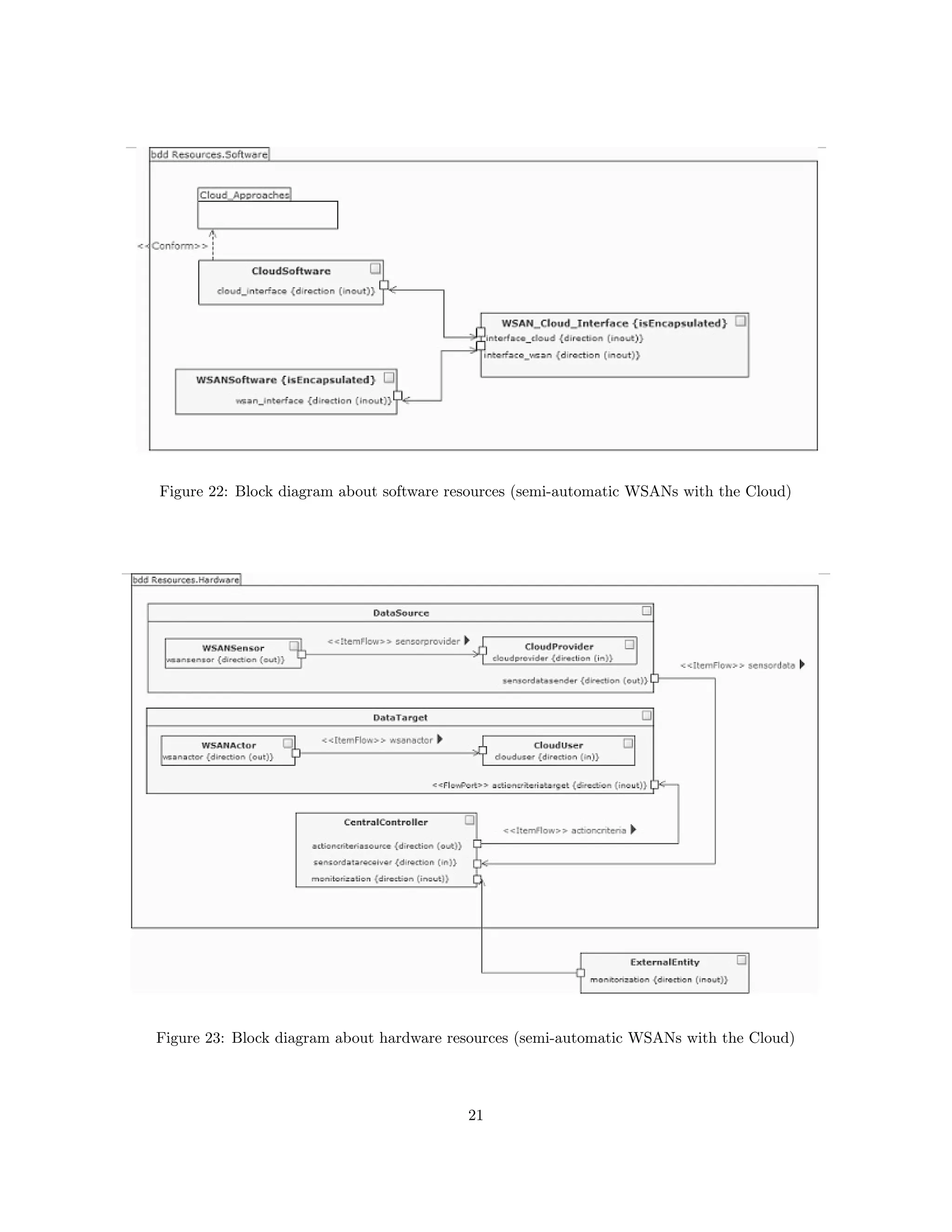
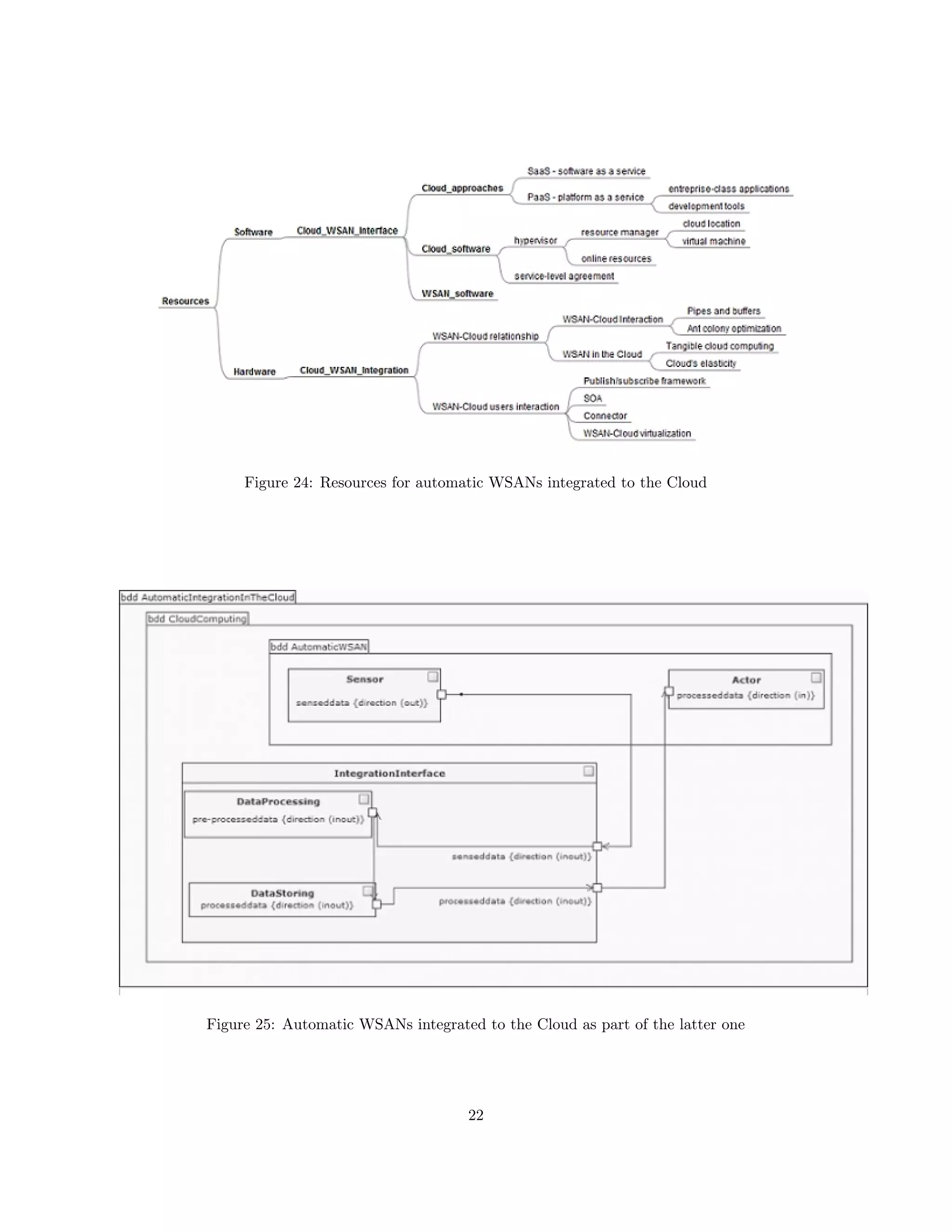
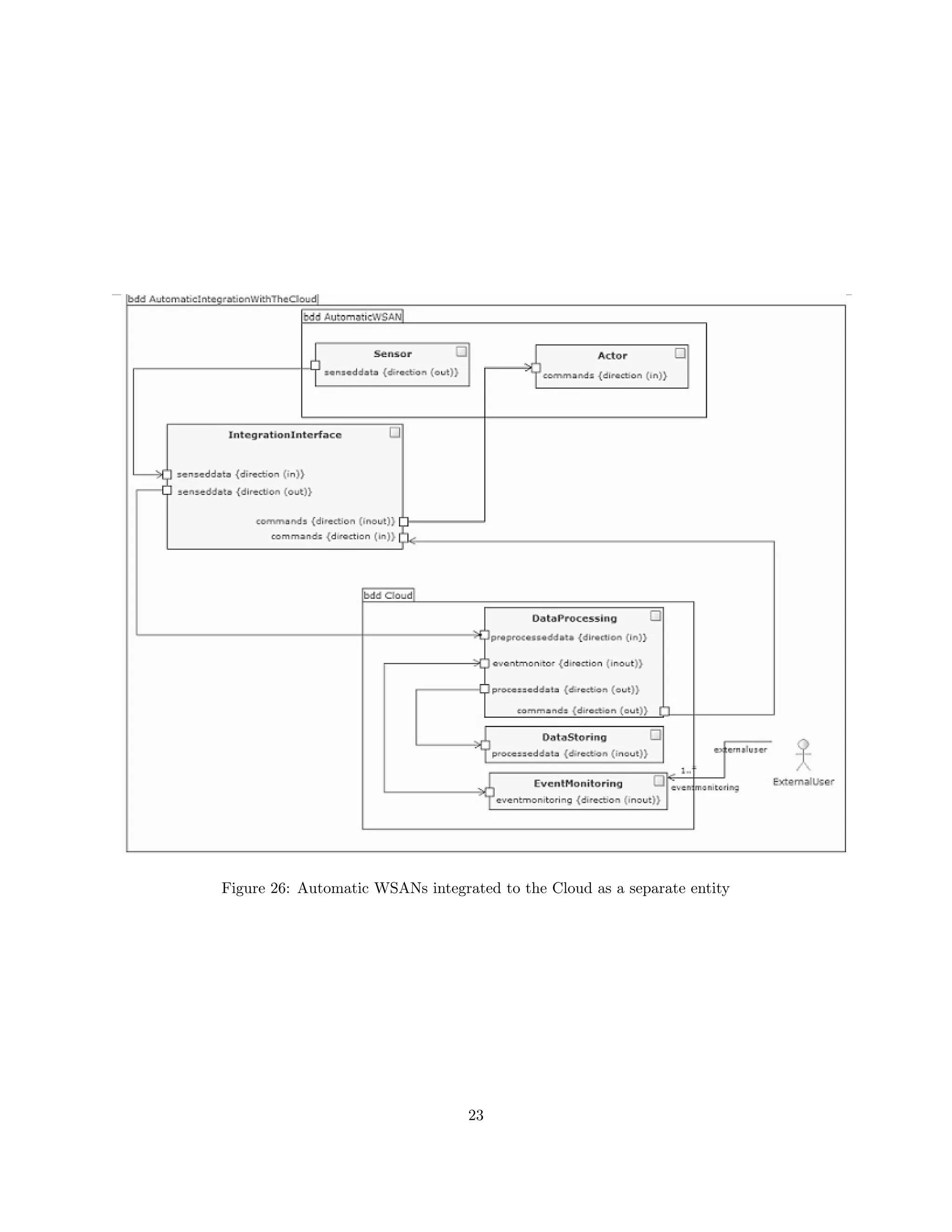
![Figure 27: Summary of ideas for WSAN-Cloud integration
Description Value
Forest area division nXn square cell, called grids
Sensor node placement center of each grid
Sensing range (r) and side of square cell
D = 2r
(D)
Node deployment deterministic and static
Cluster Head (CH) node includes nodes from a quadrant; placed at the corner of said quad-rant
Actor nodes contain fire extinguishing mechanism; are mobile; available at cen-ter
of each quadrant
Fire propagation uniform and constant speed
Table 3: Model assumptions for a WSAN application for forest fire detection and extinguishing [18]
the sensed data to a central controller, characterized by the Cluster Head node, and then the latter one
issues the commands to the corresponding actors. Again, a Publish/Subscribe method is suggested for this
application. In this approach, the monitoring of the WSAN will be performed via the Cloud (Figure 30).
Figure 31 portrays the design of the Fire Detection and Extinguishing WSAN integrated to the Cloud.
The control of the WSAN is performed by an ExternalUser, which might be a human user or any other
entity. This control is carried out through the Publish/Subscribe model, which is allocated in the Cloud and
has direct relationship to the Cloud users and providers.
On the other hand, the CloudProvider block is allocated from the BeaconNode block and the CloudUser
block is allocated from the BeaconNode block. These two allocations imply a direct relationship between
the WSAN under study and the Cloud. The ClusterHeadNode receives the sensed data from the BeaconN-ode
and sends the command to the corresponding Actor. The block ActionArea comprises the necessary
information about the geographical area where the actor will execute the received commands. It is impor-tant
to note that the ClusterHeadNode does not act independently from the Cloud, it is controlled by the
Publish/SubscribeModel block, which is inserted within the Cloud.
The flow of data among the different blocks is spread through ports. For instance, when the BeaconNode
block transmits the sensed data, it does so through the port “beaconodepacket”, with direction(out) towards
the port in the ClusterHeadNode also called “beaconodepacket”, but with direction(in), which means it
receives the sensed data. When the ClusterHeadNode block issues the commands, it does so via the port
“clusterheadnodepacket” with direction(out), heading to the port with the same name but located in the
Description Formula
Distance for actor movement d =
p
b2 + c2 since cos90 = 0
Angle to reach target area = arctan(y=x)
Table 4: Formulas for a WSAN application for forest fire detection and extinguishing [18]
24](https://image.slidesharecdn.com/articlemanuscript-141105072154-conversion-gate01/75/WiSANCloud-a-set-of-UML-based-specifications-for-the-integration-of-Wireless-Sensor-and-Actor-Networks-WSANs-with-the-Cloud-Computing-24-2048.jpg)
![Figure 28: Quadrant model with different nodes [18]
Figure 29: Sensor placement at the intersection of grid
points [18]
XC YC CHNO
x Coordinate y Coordinate Cluster Head
Number to
which packet
is to be sent.
Table 5: Format for the Beacon Node Packet [18]
Actor block and with direction(inout) which implies that the actor can both receive the commands and send
its status to the ClusterHeadNode.
Utilities like data storage and retrieval are managed via the Cloud. Data filtering is performed by
the ClusterHeadNode, which in turn is under the control of the cloud. Besides, the cloud also controls
the security, data access rules, and notification services via the Publish/Subscribe model inserted within it.
Theoretically, the cloud is highly scalable, for this reason, the number of sensor nodes and actors can increase
without affecting the performance of the integration. These utilities are part of the DevelopmentAspects
which considers the Cloud as a separate entity; for this reason, they are not explicitly indicated in the
integration diagram.ls the security, data access rules, and notification services via the Publish/Subscribe
XC YC QNO AA
x Coordinate y Coordinate Quadrant
Number
Address of
the Actor to
which the
Packet is to
be sent.
Table 6: Format for the Cluster Head Node Packet [18]
Figure 30: Schema for Cloud and Fire detection and extinguishing WSAN
25](https://image.slidesharecdn.com/articlemanuscript-141105072154-conversion-gate01/75/WiSANCloud-a-set-of-UML-based-specifications-for-the-integration-of-Wireless-Sensor-and-Actor-Networks-WSANs-with-the-Cloud-Computing-25-2048.jpg)

![included the components, their structure, their relationship and how the data flowed from one block to
another. SysML is under development and for this reason the tools applied in this study are still in the
early beginnings; for this reason, full compliance of the SysML specifications is not evident, reflected in the
existence of explanations throughout this work.
In general, this work aimed to offer some guidelines when designing the integration of WSANs to the
Cloud Computing. The objectives were reached in their totality. However, there are several issues that need
further research. For example, the models presented should be tested in more consistent designing tools,
which should be ready in the short run. Moreover, a simulation of the integration is suggested to check the
validity of this proposal.
References
[1] Ian F. Akyildiz and Ismail H. Kasimoglu. Wireless sensor and actor networks: research challenges.
Elsevier: Science Direct, 2:351 – 367, 2004.
[2] Rosy Aoun, Chinwe E. Abosi, Elias A. Doumithc, Reza Nejabati, Maurice Gagnaire, and Dimitra Sime-onidoub.
Towards an optimized abstracted topology design in cloud environment. Future Generation
Computer Systems, 29:46 – 60, 2012.
[3] Michael Armbrust, Armando Fox, Rean Griffith, Anthony D. Joseph, Randy Katz, Andy Konwinski,
Gunho Lee, Dav id Patterson, Ariel Rabkin, Ion Stoica, and Matei Zaharia. A view of cloud computing.
Communications of the ACM, Volume 53 Issue 4,:50 – 58, April 2010.
[4] Rick Blaisdell. Cloud computing standards: is it time? http://www.cloudtweaks.com/2011/09/
cloud-computing-standards-is-it-time/, September 2011.
[5] Eclipse Bugs. Bug 315780 - [sysml] papyrus shall support sysml requirement diagram. {https://bugs.
eclipse.org/bugs/show_bug.cgi?id315780}, June 2010.
[6] Rajkumar Buyya, Chee Shin Yeo, Srikumar Venugopal, James Broberg, and Ivona Brandic. Cloud
computing and emerging it platforms. Future Generation Computer Systems, 25(6), June 2009.
[7] Dung Van Dinh, Minh Duong Vuong, Hung Phu Nguyen, and Hoa Xuan Nguyen. Wireless sensor actor
networks and routing performance analysis. International Workshop on Wireless Ad-hoc Networks, 2005.
[8] Davide Frey and G.C. Roman. Context-aware publish subscribe in mobile ad hoc networks. Coordination
Models and Languages, pages 37 – 55, 2007.
[9] Robert Greene. Objects, databases and the myth of serialization. Technical report, Versant Corporation,
2011.
[10] Werner Kurschl and Wolfgang Beer. Combining cloud computing and wireless sensor networks. Pro-ceedings
of the 11th International Conference on Information Integration and Web-based Applications
Services, pages 512–518, 2009.
[11] Peter Langendoerfer, Krzysztof Piotrowski, Manuel Díaz, and Bartolomé Rubio. Distributed shared
memory as an approach for integrating wsns and cloud computing. Workshop on Wireless Sensor
Networks: Architectures, Deployments and Trends., 2012.
[12] Inc Object Management Group. Omg systems modeling language. http://www.omgsysml.org/
#What-Is_SysML, 2011.
[13] Cross Institutional Group Pursuing Clarity of Standards Landscape. Cloud standards wiki. http://
cloud-standards.org/wiki/index.php?title=Main_Page#Cloud_Standards_Coordination, Jan-uary
2012.
27](https://image.slidesharecdn.com/articlemanuscript-141105072154-conversion-gate01/75/WiSANCloud-a-set-of-UML-based-specifications-for-the-integration-of-Wireless-Sensor-and-Actor-Networks-WSANs-with-the-Cloud-Computing-27-2048.jpg)
![[14] 2011 6th International Conference on System of Systems Engineering (SoSE), editor. Putting order into
the cloud: Object-oriented UML-based enforcement for document and application organization. Dept.,
Naval Postgrad. Sch., Monterey, CA, USA, IEEEXplore Digital Library, June 2011.
[15] Jie Tao, Holger Marten, David Kramer, and Wolfgang Karl. An intuitive framework for accessing
computing clouds. International Conference on Computational Science, 4:2049 to 2057, 2011.
[16] Jamie Walters. Ripples across the internet of things: Context metrics as vehicles for relational self-organization.
http://miun.diva-portal.org/smash/record.jsf?searchId=1pid=diva2:437970,
2011.
[17] Brian Willard. Uml for systems engineering. Computer Standards Interfaces, 29:69 – 81, 2007.
[18] M.P.Sivaram Kumar y S.Rajasekaran. Detection and extinguishing forest fires using wireless sensor and
actor networks. International Journal of Computer Applications, 24:31–35, 2011.
[19] Feng Zhao and Leonidas J. Guibas. Wireless Sensor Networks: An Information Processing Approach.
The Morgan Kaufmann Series in Networking. Electronics Electrical. Elsevier/Morgan Kaufmann
Publishers, 2004.
28](https://image.slidesharecdn.com/articlemanuscript-141105072154-conversion-gate01/75/WiSANCloud-a-set-of-UML-based-specifications-for-the-integration-of-Wireless-Sensor-and-Actor-Networks-WSANs-with-the-Cloud-Computing-28-2048.jpg)